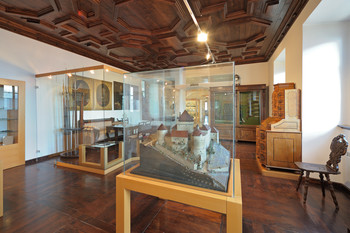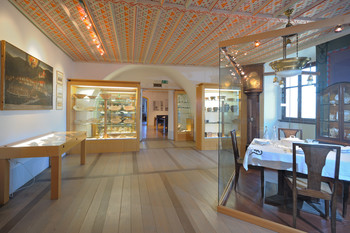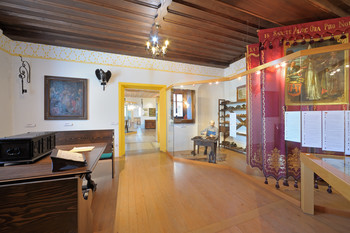Historical Collections
Škofja Loka Seigniory
The collection presents the history of the Škofja Loka Seigniory, which was founded in 973, when the Holy Roman Emperor Otto II bestowed the present-day Old Loka (Stara Loka), the Selca and Poljane Valleys, and the Sora Plain on the bishop of Freising, Abraham. The seigniory's settlement, trade connections and some important bishops from Freising in Bavaria are presented, as are the Freising manuscripts (Brižinski spomeniki), the oldest preserved texts in Slovenian used by Bishop Abraham in liturgy. A replica of Wolfgang Schwarz's plaque from 1513 features one of the oldest known coats of arms of the town of Škofja Loka.
Škofja Loka Castles
The defence of the Škofja Loka Seigniory was provided by three castles, namely the Tower on the Krancelj Hill, Wildenlack – the Old Castle below Lubnik and the Škofja Loka Castle. The seigniory's first administrative centre was the Tower on the Krancelj Hill dating back to the 12th century, which was destroyed by the 1511 earthquake. Its role was taken over by the Škofja Loka Castle, whose earliest mention as a strongly fortified castle goes back to the early 13th century. A great deal about life at the castles, the castles' defensive role and the homes of the local nobility is revealed by two scale models, old depictions, medieval finds and the castle furnishings.
The Town of Škofja Loka
Škofja Loka was a private town subordinated to the Bishop of Freising. The town developed on the terraced ground above the confluence of the Selška and Poljanska Sora rivers and was enclosed by the city walls. An important transportation route led through the town and a number of crafts and skilled trades developed in it. The town's urban development is shown by various scale models and old vedutas, and the everyday life of the townspeople is revealed by the archaeological finds and a dining room dating back to the early 20th century. Over the centuries, the town was devastated by numerous epidemics of infectious diseases and natural disasters, as evidenced by a votive painting titled ‘Sopotniška Loka’, which depicts the fire of 1698.
Guilds, Education
Guilds were associations of persons of the same trade or pursuits. In the Middle Ages, town-based craftsmen joined guilds to protect themselves from the competition of their rural counterparts; in Škofja Loka, this was the case from the mid-15th century onwards. The collection showcases the heritage of the blacksmiths', shoemakers', tanners', tailors', potters', bakers' and butchers' guilds.
The Cultural History Collection presents the development of education in Škofja Loka, ranging from the earliest schools in the Middle Ages and the Ursuline schools at Škofja Loka Castle to the establishment of the local school centre in the 20th century. It also features the so-called Škofja Loka manuscript from 1466, which is the oldest known text with Slovenian names for months.
Contemporary History Collection
The Contemporary History Collection presents the major World Wars I and II events, the interwar strike movement in the area of Škofja Loka and the reconstruction and development of the Municipality of Škofja Loka during the post-war period. The collection includes a wealth of documentary materials, photographs and objects from the 20th century.




